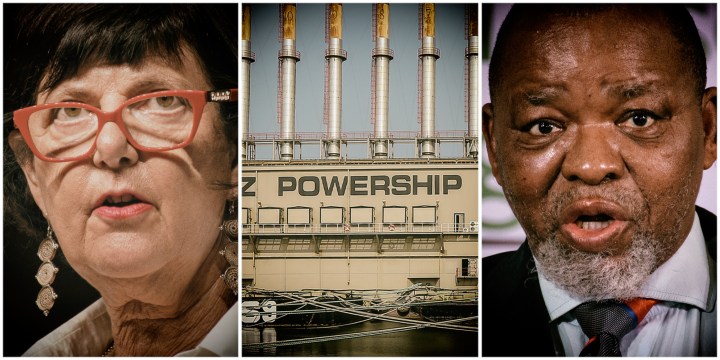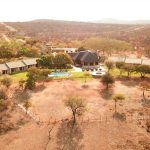POWER UP
Creecy firm in rejecting Karpowership plan — but gives Turks a third bite at the cherry

Environment minister Barbara Creecy has stood firm on her legal mandate to defend the country’s environment, declaring that support from Gwede Mantashe’s energy department for Turkish powerships cannot override the Constitution and environmental laws.
Forestry, Fisheries and Environment Minister Barbara Creecy has noted that, “The alleviation of the current energy crisis may be vital, but this does not mean that it must be achieved by this specific (Karpowership) project. Nor does it follow that there is now a licence to ignore all relevant environmental considerations.”
And yet, Creecy has given the controversial Turkish Karpowership group a third bite at a multibillion-rand, 20-year energy contract cherry — by granting the company another chance to “rectify” the manifest failures in its flawed and incomplete environmental impact assessment (EIA) process.
Significantly, the EIA was preceded by a cynical and possibly fraudulent attempt to circumvent the EIA process entirely by exploiting “emergency approval” loopholes under Section 30A of the National Environment Management Act at the height of the Covid-19 crisis.
In emphatic written decisions dated 1 August, Creecy dismissed all three appeals by the Istanbul-based Karpowership group against the rejection by her department of their EIA proposals.
The company hopes to generate 1,220MW of electricity by docking several gas-burning power and allied supply ships in the Richards Bay, Ngqura and Saldanha harbours.
‘Special weighting’
Creecy said Karpowership’s consultants, economic allies and legal representatives had tried to brush aside significant environmental concerns and persuade her that energy and socioeconomic considerations should be given a special weighting in the EIA approval process — and that there should also have been a special intergovernmental consultation process for this Strategic Integrated Project.
Creecy was not impressed by these arguments, declaring that in terms of Section 24 of the Constitution, she had the imperative to protect the environment for current and future generations and to ensure that all development was ecologically sustainable.
In response to criticism from several business lobbies, including the National African Federated Chamber of Commerce, Black Entrepreneurs Stand Together and the Eastern Cape Maritime Business Chamber, Creecy acknowledged that the government’s 2019 energy path did not exclude gas-fired power plants.
However, she said: “Karpowership is not the only entity that can deliver this result, and refusing their application for authorisation simply means that from the perspective of environmental governance, the proposed activities cannot be supported.
“Therefore, I do not agree with the argument that because this specific application for environmental authorisation was refused, therefore a general national policy was contradicted.”
Her rulings, running to roughly 100 pages each for the three harbour proposals, make it clear that both she and her department remain concerned about several aspects of the Karpowership plan.
These included the climate change impacts of emitting millions of tonnes of greenhouse gases and significant risks to fisheries, birds and marine organisms from underwater noise or hot water expulsions from the powerships’ turbochargers, exhaust stacks and cooling water circuits.
Why the lifeline?
While many will applaud Creecy and her officials for seemingly holding the line against actual or perceived political pressure by those with vested interests in the gas project, questions now arise about why has she thrown another last-minute lifeline to Karpowership to correct its failures and attempted shortcuts.
According to the appeal ruling, Creecy has the legal discretion to fashion a “just and equitable remedy” to address any shortfalls or irregularities in the EIA process.
“In my consideration of all the relevant information before me, I find that there are various gaps in information and procedural defects in relation to the public participation process that led to the rejections of the EA application. The gaps in information and procedural defects are material and fatal and cannot be cured during the current appeal process.”
In exercising her discretion on the matter, she said various interests that might be affected by her proposed remedy should be weighed.
“This should at least be guided by the objective to address the wrong occasioned by the infringement; deter future violations; make an order which can be complied with; and which is fair to all those who might be affected by the relief.”
Therefore, she had decided to remit the matter to her department so that “various gaps and defects” in the public procedure process could be addressed during the “reconsideration and re-adjudication” of the environmental approval process.
Time limits
The proviso is that this reconsideration process should comply with the time frames stipulated in the 2014 EIA Regulations.
Neither her department nor Karpowership has responded to our questions on the duration of these new time limits. But according to senior Durban environmental attorney Jeremy Ridl, the Turks may now get another 106 days, or 156 days, to submit a revised EIA report, depending on the processes followed. Thereafter, Creecy’s department would have another 107 days to make a final decision.
Ridl said that while these time frames provided for a minimum of 30 days for public participation, the public would be at a considerable disadvantage while preparing or evaluating expert opinions.
The fact that Creecy had granted Karpowership another bite at the EIA cherry suggested to him that she was inclined to grant final authorisation at a later stage if the company could address the identified defects.
It was also possible, however, that Creecy was simply being cautious in following due legal process and giving Karpowership one final opportunity to repair defects.
Visit Daily Maverick’s home page for more news, analysis and investigations
Yet, because the ANC government and energy minister Mantashe appeared to have “bent over backwards” to support the Karpowership proposal, Ridl questioned whether the voice of a lone environment minister could sway opinions at Cabinet level.
Nevertheless, Creecy’s appeal ruling gave short shrift to Karpowership’s assertions that she could overlook “micro” environmental impacts in degraded “brownfields harbours”.
“The gaps, limitations and inconsistencies provided in the socioeconomic assessment report had the effect of excluding critical environmental concerns from the EIA, that Karpowership attempts to rationalise based on its own notion of development and improvement of the South African economy.”
Breeding and nursery areas
Far from being heavily degraded industrial harbours, Creecy noted that the 57km2 Saldanha Bay/Langebaan Lagoon was the largest body of wave-sheltered water on the South African coast and provided a critical nursery area for both seabirds and fish such as harders, silverside, stumpnose, goby and blacktail.
Algoa Bay and its islands also provided food, shelter and breeding areas for several sea birds — including the largest breeding ground of the endangered African penguin (about 35% of the global and 42% of the South African population) and the world’s largest population of Cape gannets.
Similarly, Richards Bay harbour and its adjoining mud flats and nature reserve provided a critical nursery area for numerous fish species — not just for the benefit of anglers in the harbour, but the KZN region as a whole.
Underwater noise
Whereas Karpowership had proposed that further studies about underwater noise be deferred until after the powerships had been given the go-ahead, Creecy said this would defeat the purpose of an EIA — namely to identify potential negative impacts before they occurred.
This was especially critical for a power technology that had never been used in South Africa, she said, emphasising the need for a more rigorous, detailed and cautious assessment of underwater noise impacts.
According to submissions made to Creecy by several environmental NGOs, the final EIA report did not contain an adequate assessment of underwater noise impacts generated by powerships in the three harbours for up to 24 hours a day for two decades.
Creecy appears to acknowledge these concerns in her ruling, noting that noise impacts had not been assessed adequately. One of the technical studies noted that marine animals could suffer extensive damage to their hearing systems, haemorrhaging, damage to internal organs and disruption to communication and feeding.
These specialist reports indicated that concerns around human-induced noise in the sea were valid. She also concurred with senior officials in her department’s Oceans and Coasts branch, who voiced concern that there was still “considerable uncertainty” around the potential noise impacts from powerships.
One of the specialist reports also suggested that additional noise “could be disastrous for the ecology” if it exceeded ecological thresholds or could not be mitigated (by silencing equipment and other methods).
Sea heating
Another issue of concern was the additional heat in the sea around powerships due to cooling water emissions that could potentially affect the food chain, from tiny plankton to small fish and much larger marine animals.
She remarked that specialist studies and the final EIA report were “not always entirely convincing” in dismissing concerns around heated seawater discharges, which could result in temperature increases of up to 15°C in the vicinity of the powerships.
In her ruling, Creecy was at pains to emphasise her belief that the fundamental environmental rights in Section 24 of the Constitution were “distinctly anthropocentric in nature”.
“The ultimate aim of these fundamental rights is not the conservation or protection of the environment for the sake of the environment itself, but the aim therof is the responsible utilisation of natural resources for satisfying the needs of humans.
“In this context, I also have the constitutional and legal obligation not to allow a preventable state of affairs in an environment that may potentially or actually harm the health or well-being, in a wide sense, of another person or persons. The ‘need and desirability’ of a proposed project should also be considered in this context.”
Karpowership response
We asked Karpowership whether it was considering taking Creecy’s ruling on judicial review, and if not, what time window was left for the “remittal and reconsideration process” by the Department of Fisheries, Forestry and Environment.
The company did not respond to our questions, but issued this response:
“Karpowership operates in 25 countries across the globe. We take great pride in our track record of environmental stewardship, and we have always placed top priority in our ability to comply with international environmental legislation. Our desire to serve as a good corporate citizen to the people of South Africa and comply with South Africa’s environmental laws is a driving force of this project.
“We respect Minister Creecy’s exercise of her powers, but we are very disappointed with the outlook, especially given the time it took to make a decision. While we disagree with the findings on Friday’s report, we agree with the independent arbiter that there are no fatal flaws in the Karpowership SA EIA.
“We appreciate the DFFE’s remission of our EIA to the competent authority, which allows us the opportunity to address perceived gaps, and we hope that the process will be much timelier than it has been to date.
“We all have the same mission — to rapidly provide power to the South African people and to implement solutions that ensure environmental protections and ecologically sustainable development. In order meet these goals, we need a collaborative partner in the government who follows timetables laid out in South African law.
“Floating Gas to Power is embraced in Europe, the United States and Asia because the projects take less than one year to build and deliver clean, affordable and reliable power without the destruction of ecosystems on thousands of hectares of land.
“South Africa needs dispatchable power now and, with the support and collaboration of the government, we are confident that we can address all EIA concerns and deploy projects that will power 800,000 homes and end one full stage of load shedding.
“We remain committed to being part of South Africa’s energy security solution and are ready to deploy our Powerships immediately.” DM/OBP



















 Become an Insider
Become an Insider
All of this for ONE STAGE of load-shedding!! I’m so sick of these shenanigans by evil agents